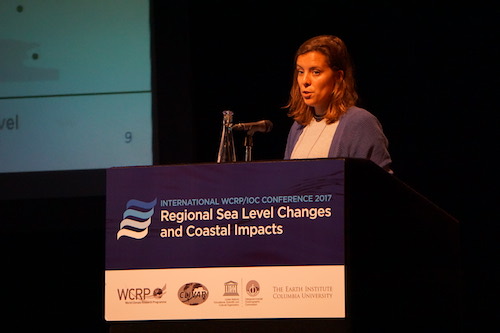WCRP/IOC Sea Level Conference: Day 3 Highlights

Risk, adaptation strategies, and stakeholder needs for coastal zone management
Halfway through the conference, day three brought a series of presentations on the coastal zone. Presenters in the two plenary sessions discussed impacts of rising seas from small island countries to large metropolitan cities like Shanghai, planning and adaptation strategies, and information needs for stakeholders and decision makers. Almost 70 posters were also presented on this theme. A panel closed out the day with discussions about New York’s adaptation strategies and response to Hurricane Sandy.
“Adaptation has many steps. It’s a pathway,” said Robert Nicholls, University of Southampton, when discussing planning horizons for decision makers. Klaus Jacob, University of Columbia, reminded the audience that adaptation is not just a financial problem but comes with political and ethical challenges. Josh DeFlorio of the New York and New Jersey Port Authority discussed their resiliency efforts on sea level rise, noting planning horizons for design reach out to the about 2100. Sandy served as a catalyst for the Port Authority to develop more nuanced and flexible guidelines.
In the evening, Columbia University hosted a public lecture on Sea Level Rise: Causes, Impacts, and Options for Solutions, featuring public officials, scientists, coastal managers, architects, and other stakeholders. Around 400 people attended the event in person as well as online participants. An archived recording is available here.
Below are highlights from the day’s presentations.
- For estimating flood risk, every factor contributing to local extreme water levels needs to be included: local sea level rise, tides, land subsidence, storm surge (from storms or tropical hurricanes), and wave run-up and set-up.
- Rates of land subsidence can exceed climate-induced sea level rise rates by a factor of 10 or more. Some cities, such as Tokyo and more recently Shanghai, have successfully limited subsidence through regulation. (Shujun Ye, Nanjing University)
- Including tropical cyclones in projections of extreme water levels are important to estimate present-day and future extreme sea levels (Devendra Rao Ambarukhana, Indian Institute of Technology, and Sanne Muis, Vrije Universiteit Amsterdam)
- With a flexible model mesh, it is possible to make global projections on extreme water levels (surges and tides). These global projections are very accurate, with exception of areas where tropical cyclones are present, because these are not well resolved within the reanalysis datasets. (Sanne Muis, University Amsterdam)
- There seems to be a need for improved two-way communication and more effective engagement between scientists and the diverse stakeholder community. A lack of a clear source of the best available information is a barrier to stakeholder action.
- Different decision-making contexts require different decision-making methods and scientific information. The confidence that physical scientists place on results is an essential piece of information. (Jochen Hinkel, Global Climate Forum)
- Due to a lack of consistent global storm surge/storm tide datasets and analyses, models and projections hinder coastal adaptation efforts in many places. A global scientific community effort would continue the improvements in modeling efforts, where many challenges remain. (Kathleen McInnes, CSIRO)
- The poor, who often inhabit areas are most risk, have disproportionate impacts from sea level rise. Society will continue living along the sea (in densely populated areas at least), even though it is expensive. And people may not migrate or retreat from their homes or communities just because of flooding. (Miguel Esteban, University of Tokyo)
- Scientists must engage with stakeholders as a community and on a personal level. Trust can be worth more than thousands of faceless scientists (Robert Bindschadler, NASA Emeritus/SEARCH)
- Actionable science must be co-produced between the scientific community and decision makers. When dealing with sea level rise, managers often say the issue with information is that it’s fragmented, confusing, dispersed, and complex. (Faud Sweiss, Office of Mayor Edwin Lee, and David Behar, San Francisco Public Utilities Commission)
Check out the conference Storify collection and follow #SeaLevel2017 for live updates.














Add new comment